-
 Bitcoin
Bitcoin $115100
-2.99% -
 Ethereum
Ethereum $3642
-1.38% -
 XRP
XRP $3.027
-5.51% -
 Tether USDt
Tether USDt $1.000
-0.05% -
 BNB
BNB $763.4
-1.32% -
 Solana
Solana $177.2
-5.42% -
 USDC
USDC $0.9999
-0.02% -
 Dogecoin
Dogecoin $0.2247
-6.47% -
 TRON
TRON $0.3135
0.23% -
 Cardano
Cardano $0.7824
-4.46% -
 Hyperliquid
Hyperliquid $42.53
-0.97% -
 Stellar
Stellar $0.4096
-6.09% -
 Sui
Sui $3.662
-2.61% -
 Chainlink
Chainlink $17.63
-3.57% -
 Bitcoin Cash
Bitcoin Cash $536.3
2.94% -
 Hedera
Hedera $0.2450
0.34% -
 Avalanche
Avalanche $23.23
-3.15% -
 Litecoin
Litecoin $112.2
-1.23% -
 UNUS SED LEO
UNUS SED LEO $8.976
-0.30% -
 Shiba Inu
Shiba Inu $0.00001341
-2.72% -
 Toncoin
Toncoin $3.101
-2.44% -
 Ethena USDe
Ethena USDe $1.001
-0.05% -
 Uniswap
Uniswap $10.08
-1.97% -
 Polkadot
Polkadot $3.938
-2.77% -
 Monero
Monero $323.9
0.87% -
 Dai
Dai $0.9999
-0.02% -
 Bitget Token
Bitget Token $4.481
-1.69% -
 Pepe
Pepe $0.00001199
-5.94% -
 Aave
Aave $288.2
-0.68% -
 Cronos
Cronos $0.1279
0.36%
What does the dead cross below the zero axis of DIF and DEA indicate?
A MACD dead cross below the zero axis signals strong bearish momentum, confirming a downtrend and serving as a reliable sell or short entry cue in crypto trading.
Jul 24, 2025 at 02:42 am
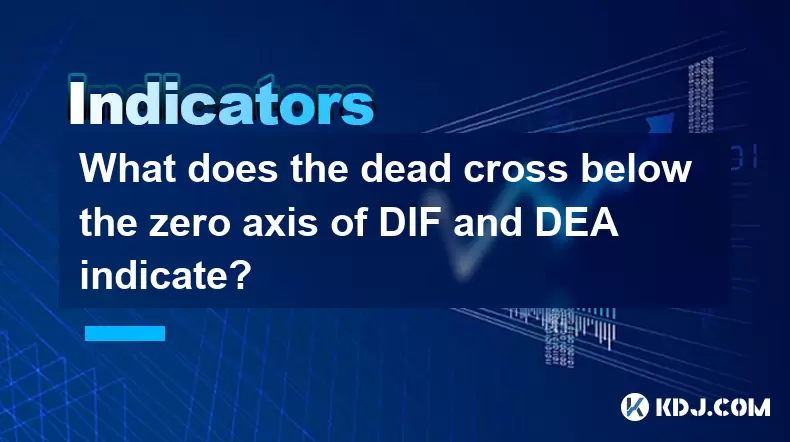
Understanding the MACD Indicator and Its Components
The MACD (Moving Average Convergence Divergence) indicator is a widely used technical analysis tool in the cryptocurrency trading space. It consists of three main elements: the DIF line, the DEA line, and the MACD histogram. The DIF line is calculated by subtracting the 26-period Exponential Moving Average (EMA) from the 12-period EMA. The DEA line, also known as the signal line, is a 9-period EMA of the DIF line. The histogram represents the difference between the DIF and DEA lines, visually indicating momentum shifts.
When analyzing price trends in cryptocurrencies such as Bitcoin or Ethereum, traders closely monitor the interaction between the DIF and DEA lines. A dead cross occurs when the DIF line crosses below the DEA line. This event is interpreted as a bearish signal, suggesting weakening momentum and a potential trend reversal from bullish to bearish. However, the significance of this cross intensifies when it happens below the zero axis.
What Happens When the Dead Cross Occurs Below the Zero Axis?
A dead cross below the zero axis indicates that both the DIF and DEA lines are in negative territory, meaning that the shorter-term momentum (12-period EMA) is not only weakening compared to the longer-term momentum (26-period EMA), but the overall trend is already in a bearish phase. This confluence of factors strengthens the bearish interpretation of the signal.
- The DIF line crossing below the DEA line shows that downward momentum is accelerating.
- The fact that this occurs below the zero axis confirms that the broader trend is bearish.
- The distance from the zero axis can reflect the strength of the downtrend—the further below zero, the stronger the bearish sentiment.
This combination is often seen as a strong sell signal or a confirmation to maintain short positions in volatile crypto markets. Traders using this signal typically avoid entering long positions until a bullish crossover above the zero axis occurs.
How to Identify the Dead Cross Below Zero in Trading Platforms
To identify this pattern on a cryptocurrency trading chart, follow these steps:
- Open a charting platform such as TradingView, Binance, or MetaTrader.
- Apply the MACD indicator to the price chart of the desired cryptocurrency (e.g., BTC/USDT).
- Observe the two lines in the MACD sub-window: the DIF (blue line) and the DEA (orange or red line).
- Check the position of both lines relative to the zero axis (horizontal midline).
- Look for a point where the DIF line crosses downward through the DEA line while both are below the zero line.
It is crucial to verify that the cross happens after both lines have already entered negative territory. A cross that dips below zero briefly and then reverses may be a false signal, especially in highly volatile crypto assets. Using higher timeframes (such as 4-hour or daily charts) can help filter out noise and increase the reliability of the signal.
Strategies for Responding to the Dead Cross Below Zero
Traders can use this signal in several strategic ways depending on their risk tolerance and trading style:
- Exiting long positions: If holding a long position in a cryptocurrency, the dead cross below zero may serve as a cue to secure profits or limit losses before further downside.
- Entering short positions: Aggressive traders may use this signal to initiate short trades, especially when confirmed by other indicators such as RSI (Relative Strength Index) showing overbought conditions prior to the cross.
- Setting stop-loss levels: For those already in short positions, the formation of this cross can be used to tighten stop-loss orders above recent swing highs.
- Avoiding counter-trend entries: This signal reinforces the idea that buying the dip may be risky until a bullish crossover above zero occurs.
It is recommended to combine this MACD signal with volume analysis and support/resistance levels. For example, if the dead cross occurs near a key support level, the bearish signal may be less reliable. Conversely, if it occurs with high trading volume and breaks below a support level, the downside potential increases.
Common Misinterpretations and How to Avoid Them
Many traders misinterpret the dead cross due to lack of context. One common mistake is acting on a dead cross that occurs above the zero axis, which carries less bearish weight. Another is reacting to a cross that happens during sideways or choppy market conditions, where MACD signals tend to produce false entries.
To avoid false signals:
- Always check whether the DIF and DEA are below the zero line before considering the cross significant.
- Use multiple timeframes to confirm the trend direction. For instance, a daily chart dead cross below zero should align with the 4-hour chart’s momentum.
- Wait for candlestick confirmation after the cross—such as a strong red candle closing lower—before executing a trade.
- Combine with trendline breaks or moving average crossovers (e.g., price below 50-day or 200-day MA) for added validation.
Ignoring these precautions can lead to premature exits or entries, especially in cryptocurrencies known for sharp reversals and whipsaws.
Frequently Asked Questions
What is the difference between a dead cross above zero and below zero?
A dead cross above zero suggests weakening bullish momentum but does not confirm a bearish trend. In contrast, a dead cross below zero occurs in an already bearish environment, indicating that downward momentum is strengthening, making it a more reliable bearish signal.
Can the dead cross below zero be used in range-bound markets?
Its effectiveness is limited in range-bound markets because MACD lines often fluctuate around the zero axis without clear trends. In such conditions, the signal may generate false exits or entries. It performs best in established downtrends or during strong trend reversals.
How long should I wait after the dead cross to take action?
It is advisable to wait for at least one full candlestick closure after the cross to confirm the move. For day traders, this could be a 1-hour or 4-hour candle; for swing traders, a daily candle. This reduces the risk of reacting to a temporary dip.
Does the dead cross below zero work the same across all cryptocurrencies?
While the principle remains consistent, highly volatile altcoins may produce more false signals due to rapid price swings. Major cryptocurrencies like Bitcoin and Ethereum tend to generate more reliable MACD signals due to higher liquidity and smoother price action.
Disclaimer:info@kdj.com
The information provided is not trading advice. kdj.com does not assume any responsibility for any investments made based on the information provided in this article. Cryptocurrencies are highly volatile and it is highly recommended that you invest with caution after thorough research!
If you believe that the content used on this website infringes your copyright, please contact us immediately (info@kdj.com) and we will delete it promptly.
- Kiyosaki's Crypto Playbook: Ditching Paper for Real Assets Like Bitcoin
- 2025-07-25 22:30:11
- Satoshi-Era Whales Stir the Bitcoin Pot: What's the Deal?
- 2025-07-25 22:30:12
- Pi Coin Value in Indian Rupees (INR) 2024: Decoding the Hype
- 2025-07-25 21:45:50
- Crypto Investing: Top Picks and Meme Coin Mania in '25
- 2025-07-25 21:52:07
- Ark Invest's Portfolio Rebalance: Coinbase, Block, and the Crypto Shift
- 2025-07-25 21:52:07
- Bitcoin's Wild Ride: Sell-offs, Volatility, and What's Next
- 2025-07-25 21:55:18
Related knowledge

How to interpret that the KDJ D line is downward for a long time but the price is sideways?
Jul 25,2025 at 07:00pm
Understanding the KDJ Indicator and Its ComponentsThe KDJ indicator is a momentum oscillator widely used in cryptocurrency trading to assess overbough...

What does it mean that the KDJ indicator forms a double bottom at a low level?
Jul 25,2025 at 05:08pm
Understanding the KDJ Indicator in Cryptocurrency TradingThe KDJ indicator is a momentum oscillator widely used in cryptocurrency trading to identify ...
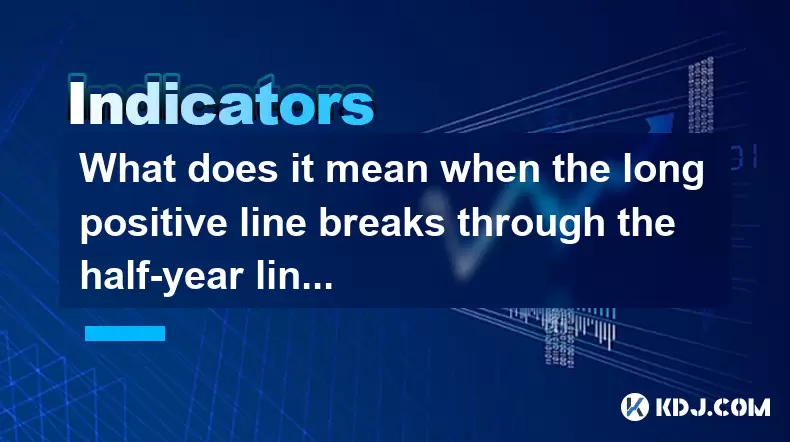
What does it mean when the long positive line breaks through the half-year line and then steps back?
Jul 25,2025 at 06:49pm
Understanding the Long Positive Line in Candlestick ChartsIn the world of cryptocurrency trading, candlestick patterns play a vital role in technical ...
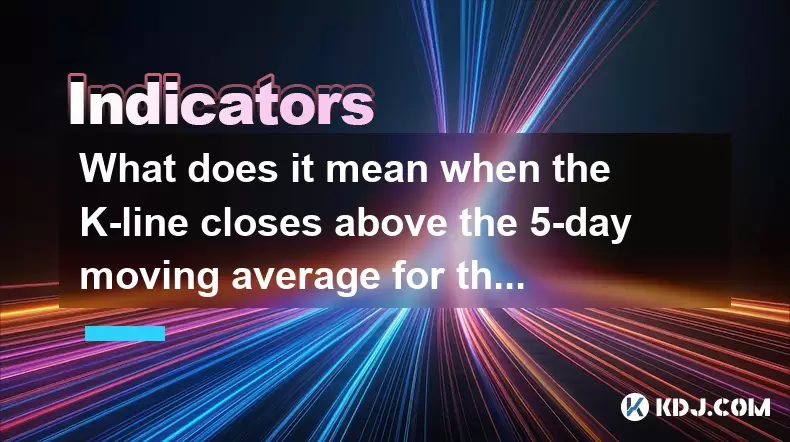
What does it mean when the K-line closes above the 5-day moving average for three consecutive days?
Jul 25,2025 at 10:07pm
Understanding the K-line and 5-day Moving AverageThe K-line, also known as a candlestick, is a critical charting tool used in technical analysis to re...
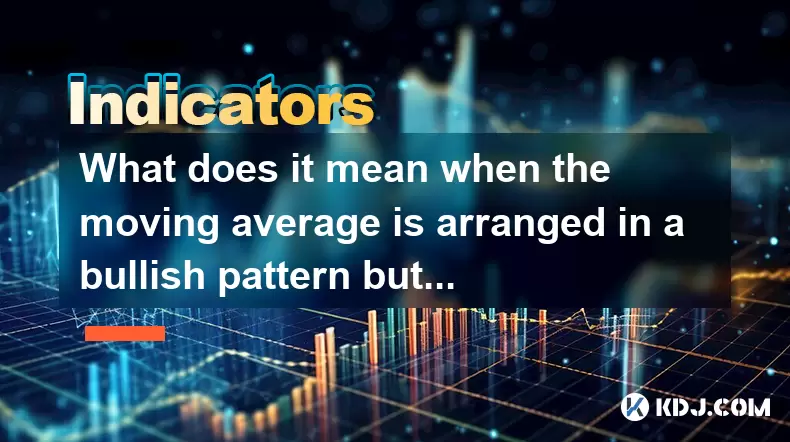
What does it mean when the moving average is arranged in a bullish pattern but the K-line closes negatively continuously?
Jul 25,2025 at 10:56pm
Understanding the Bullish Moving Average PatternWhen the moving average (MA) lines are arranged in a bullish pattern, it typically indicates that shor...
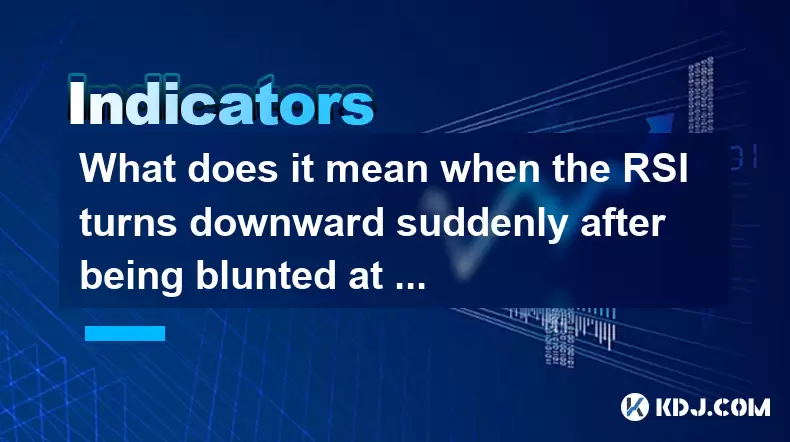
What does it mean when the RSI turns downward suddenly after being blunted at a high level?
Jul 25,2025 at 04:00pm
Understanding the RSI and Its Role in Technical AnalysisThe Relative Strength Index (RSI) is a momentum oscillator that measures the speed and change ...

How to interpret that the KDJ D line is downward for a long time but the price is sideways?
Jul 25,2025 at 07:00pm
Understanding the KDJ Indicator and Its ComponentsThe KDJ indicator is a momentum oscillator widely used in cryptocurrency trading to assess overbough...

What does it mean that the KDJ indicator forms a double bottom at a low level?
Jul 25,2025 at 05:08pm
Understanding the KDJ Indicator in Cryptocurrency TradingThe KDJ indicator is a momentum oscillator widely used in cryptocurrency trading to identify ...

What does it mean when the long positive line breaks through the half-year line and then steps back?
Jul 25,2025 at 06:49pm
Understanding the Long Positive Line in Candlestick ChartsIn the world of cryptocurrency trading, candlestick patterns play a vital role in technical ...

What does it mean when the K-line closes above the 5-day moving average for three consecutive days?
Jul 25,2025 at 10:07pm
Understanding the K-line and 5-day Moving AverageThe K-line, also known as a candlestick, is a critical charting tool used in technical analysis to re...

What does it mean when the moving average is arranged in a bullish pattern but the K-line closes negatively continuously?
Jul 25,2025 at 10:56pm
Understanding the Bullish Moving Average PatternWhen the moving average (MA) lines are arranged in a bullish pattern, it typically indicates that shor...

What does it mean when the RSI turns downward suddenly after being blunted at a high level?
Jul 25,2025 at 04:00pm
Understanding the RSI and Its Role in Technical AnalysisThe Relative Strength Index (RSI) is a momentum oscillator that measures the speed and change ...
See all articles

























































































